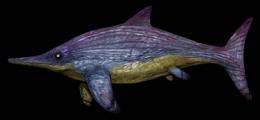The Ichthyosaurs survived longer than was thought

The discovery of a new species of ichthyosaurs considerably changes our understanding of the evolution and the extinction of these dinosaur age sea reptiles, according to a study published this week in PLoS ONE by an international team of Belgian, British and German scientists.
This work shows that the ichthyosaurs were not subject to a major extinction at the end of the Jurassic era (145 million years ago). It furthermore also shows that the ichthyosaurs remained very diversified until their definitive extinction, around 94 million years ago. These two results, springing from joint work produced by university and museum researchers in Belgium, the United Kingdom and Germany, and published in the Tuesday, January 3, 2012 edition of the open access journal PLoS One, contradicts earlier theories which considered the cretaceous ichthyosaurs as the final survivors of a group in its death throes.
The ichthyosaurs are known for being sea reptiles which superficially resemble sharks and dolphins. 'Their size could range from less than 1m in length to giants measuring over 20m. They all gave birth to their offspring directly in the sea, and certain of them were swift swimmers which could quickly dive to great depths, and had enormous eyeballs and a so-called 'hot blooded' physiology,' says the study's first author, Valentin Fischer, who works at the University of Liège (Belgium). The ichthyosaurs were a major component of the sea ecosystems during the age of the dinosaurs, and occupied numerous ecological niches.
Up until recently it was thought that a major extinction on the Jurassic-Cretaceous Boundary had eradicated the diversified forms of the Jurassic era, to the benefit of less specialised forms. These few survivors of the Cretaceous period were thought to have subsequently some fifty million years later, over the course of the Cenomanian era (Late Cretaceous). Nonetheless, the cruel lack of fossils in the lower Cretaceous prevented a clear understanding of dynamics of the shift from the diversified ichthyosaurs of the Jurassic to the rare and generalised forms of the Cretaceous.
The team tackled the subject in two stages. The first was to examine the existing specimens of Cretaceous ichthyosaurs in order to determine how many different species they could constitute. Some of these fossils have been discovered recently whilst others have been in museum collections for decades. At least one new Cretaceous ichthyosaurus, known through English and German fossils, has been discovered over the course of the research process. The team has named it Acamptonectes densus. 'This name means a 'rigid and compact swimmer' and refers to the fact that the skull and vertebral column of this ichthyosaurus were very strong and tightly locked together. This indicates that practically all the movements involved in swimming were restricted to the tail and the caudal fin,' explains Valentin Fischer. The second stage of the research process was to use two techniques (phylogenetic analysis and survival/extinction rates) to evaluate the effect of the crisis of the Jurassic-Cretaceous Boundary on the ichthyosaurs.
No extinction on the Jurassic-Cretaceous Boundary ...
Several lines of ichthyosaurus appeared during the Middle Jurassic period. Whilst it had been thought that these Jurassic ichthyosaurs died a little later at the end of the Jurassic, the new discoveries show that in reality almost all of these lines survived across the Jurassic-Cretaceous Boundary. On the basis of this data, new information provided by the Acamptonectes and other research, the team has been able to show that the extinction rates were very low during the Jurassic-Cretaceous Boundary. In fact it seems that the ichthyosaurs were not affected by the Jurassic-Cretaceous Boundary extinction event, contrary to many other groups of marine animals. The reason why the ichthyosaurs did so well during this period in comparison with other groups of marine animals remains a mystery, and will be the subject of future research.
... But a severe final extinction
The results also indicate that the 'last' ichthyosaurs were surprisingly diversified and belonged to distinct groups. The researchers can now affirm that the ichthyosaurs were more numerous and less rare during the Cretaceous era than had been thought up until now. The definitive extinction of the ichthyosaurs—which occurred around 94 million years ago—long before the famous extinction event at the end of the Cretaceous era, 65 million years ago—was thus a more serious event than had been recently supposed.
More information: Valentin Fischer, et al. 2012. New ophthalmosaurid ichthyosaurs from the European Lower Cretaceous demonstrate extensive ichthyosaur survival across the Jurassic-Cretaceous boundary. PLoS ONE, (7(1) :e29234. DOI:10.1371/journal.pone.0029234
Journal information: PLoS ONE
Provided by University de Liege




















